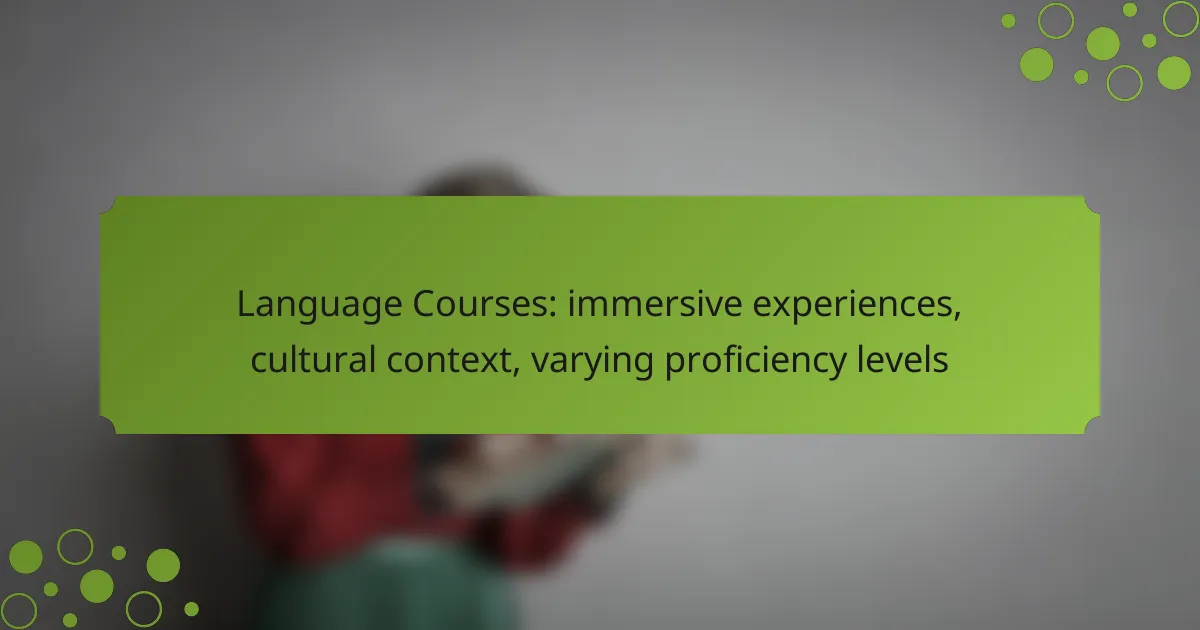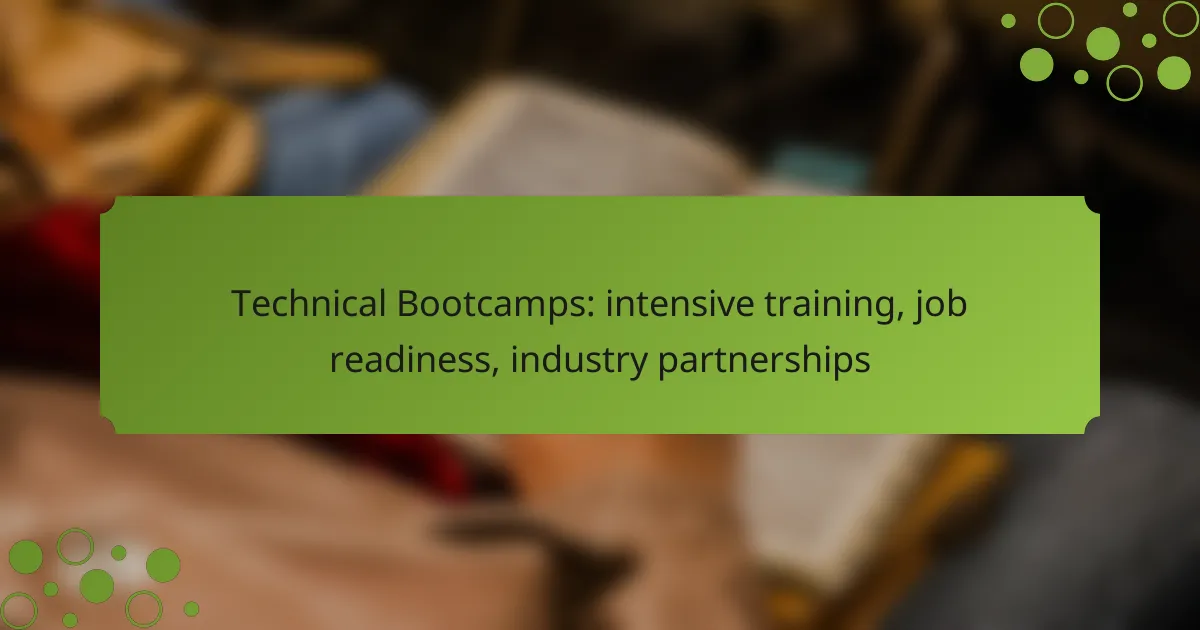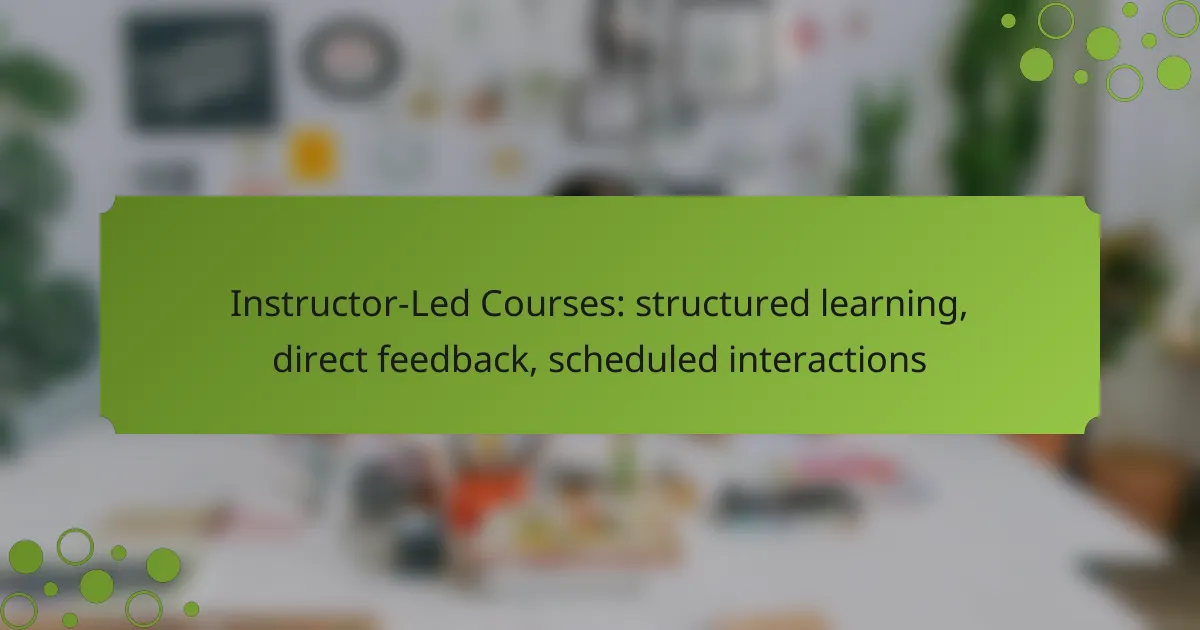Full degree programs provide essential formal qualifications that significantly enhance career advancement opportunities. By equipping individuals with the necessary knowledge and skills, these programs make graduates more competitive in the job market, catering to a variety of fields and career aspirations. How […]
Online courses have transformed education by offering various formats to suit different learning styles and goals. From self-paced options that provide flexibility to live instructor-led sessions that foster real-time interaction, each type presents unique advantages. Understanding these differences can help learners choose the best path for their educational journey.
Online language courses that focus on immersive experiences offer a unique blend of interactive learning and cultural context, significantly enhancing the language acquisition process. By incorporating real-life scenarios and multimedia resources, these programs engage learners at varying proficiency levels—beginner, intermediate, and advanced—ensuring […]
Technical bootcamps provide intensive training designed to equip students with practical skills and real-world applications, ensuring they are job-ready upon graduation. By collaborating with industry leaders, these programs tailor their curricula to meet current market demands, often including hands-on projects and job […]
Micro-credentials are designed to facilitate focused skill acquisition through targeted learning experiences that emphasize specific competencies. With shorter durations and industry recognition, these credentials empower learners to quickly enhance their qualifications, making them more competitive in the job market. How do micro-credentials […]
Feedback mechanisms play a crucial role in enhancing online courses by systematically collecting student input to inform necessary adjustments. By integrating student suggestions, educators can tailor their content and teaching methods, ultimately improving the learning experience and increasing overall satisfaction. How can […]
MOOCs, or Massive Open Online Courses, have transformed the educational landscape by enhancing accessibility and reducing costs, making learning opportunities available to a broader audience. Unlike traditional courses that often come with significant tuition fees, MOOCs can be accessed for free or […]
Overcoming language barriers is crucial for effective communication in our increasingly globalized world. Utilizing translation tools and bilingual resources can greatly enhance understanding and engagement with different cultures. Additionally, building a strong vocabulary is essential for improving language skills, enabling clearer expression […]
Instructor-led courses provide a structured learning environment that emphasizes direct feedback and scheduled interactions, making them an effective choice for skill acquisition. By fostering engagement between instructors and students, these courses enhance the educational experience and cater to various subjects and skill […]
Specialization tracks offer a focused approach to career advancement by diving deep into high-demand skills that align with industry needs. Led by experts, these courses provide practical knowledge and real-world applications, enhancing both employability and promotion potential. Participants typically need foundational knowledge […]
Hybrid learning models integrate online and in-person education, providing a flexible approach that accommodates diverse learning styles and schedules. This innovative method enhances student engagement and allows for personalized educational experiences, making learning more accessible and effective. What are the benefits of […]
What are the most popular types of online courses?
The most popular types of online courses include self-paced courses, live instructor-led courses, micro-credential programs, bootcamps, and subscription-based courses. Each type offers unique benefits and considerations, catering to different learning preferences and goals.
Self-paced courses
Self-paced courses allow learners to progress through the material at their own speed, making them ideal for individuals with busy schedules. These courses often include pre-recorded lectures, readings, and quizzes that can be accessed anytime.
When choosing a self-paced course, consider the time commitment required to complete it. Many courses can take anywhere from a few weeks to several months, depending on the depth of the content. Look for courses that provide clear deadlines or milestones to help keep you on track.
Live instructor-led courses
Live instructor-led courses offer real-time interaction with instructors and fellow students, creating an engaging learning environment. These courses typically follow a set schedule, with classes held at specific times, often via video conferencing platforms.
These courses are beneficial for those who thrive on direct feedback and interaction. However, they require a commitment to attend classes at designated times, which may not suit everyone’s schedule. Check for recorded sessions if you anticipate missing any live classes.
Micro-credential programs
Micro-credential programs focus on specific skills or knowledge areas and typically culminate in a certificate or badge upon completion. These programs are designed to provide targeted learning that can enhance your resume or professional skills.
These programs can range from a few weeks to several months and often include assessments to validate your learning. They are particularly useful for professionals looking to upskill or pivot in their careers without committing to a full degree program.
Bootcamps
Bootcamps are intensive, short-term training programs that focus on practical skills in areas like coding, data science, or digital marketing. They are designed to equip learners with job-ready skills in a condensed timeframe, often lasting from a few weeks to a few months.
While bootcamps can be a fast track to a new career, they often require a significant time investment and can be costly. Research the bootcamp’s job placement rates and alumni reviews to ensure it aligns with your career goals.
Subscription-based courses
Subscription-based courses provide access to a library of courses for a recurring fee, usually monthly or annually. This model allows learners to explore various subjects and skills without committing to a single course.
These platforms often offer flexibility and a wide range of topics, making them suitable for lifelong learners. However, be mindful of the subscription costs and ensure you are actively engaging with the content to maximize your investment.
How do online courses compare in terms of cost?
Online courses vary significantly in cost, influenced by factors such as course format, duration, and the institution offering them. Generally, self-paced courses tend to be more budget-friendly, while live courses and bootcamps often come with higher price tags.
Self-paced courses are often more affordable
Self-paced online courses typically range from free to a few hundred dollars. These courses allow learners to progress at their own speed, which can be appealing for those balancing other commitments. Many platforms, such as Coursera and Udemy, offer frequent discounts, making these courses even more accessible.
When considering self-paced options, look for courses that provide comprehensive materials and support. Some may charge extra for certification or additional resources, so factor these costs into your budget.
Live courses may have higher fees
Live online courses, which include real-time interaction with instructors and peers, usually come with higher fees, often ranging from several hundred to a few thousand dollars. The added value of immediate feedback and networking opportunities justifies the cost for many learners.
Before enrolling in a live course, check the institution’s reputation and the qualifications of the instructors. Ensure that the course content aligns with your learning goals, as this can help you make the most of your investment.
Bootcamps usually require a significant investment
Bootcamps, particularly in tech fields like coding or data science, often demand a significant financial commitment, typically ranging from a few thousand to over ten thousand dollars. These intensive programs are designed to equip students with job-ready skills in a short time frame, usually lasting a few months.
When evaluating bootcamps, consider their job placement rates and alumni reviews. Some programs offer financing options or income share agreements, which can ease the upfront cost burden. Research thoroughly to ensure the bootcamp aligns with your career aspirations and offers a solid return on investment.
What are the benefits of self-paced online courses?
Self-paced online courses offer significant advantages, including flexibility in scheduling and the ability to learn at your own speed. These courses cater to diverse learning styles and lifestyles, making education more accessible for many individuals.
Flexible scheduling
One of the primary benefits of self-paced online courses is the flexible scheduling they provide. Learners can choose when to study, allowing them to balance their education with work, family, or other commitments. This flexibility is particularly beneficial for those with unpredictable schedules.
For instance, a working professional can allocate time during evenings or weekends to complete course modules. This adaptability helps reduce stress and increases the likelihood of course completion.
Personalized learning pace
Self-paced courses allow learners to progress through material at a speed that suits them. This personalized learning pace means that individuals can spend more time on challenging topics while quickly moving through material they already understand. Such an approach can lead to better retention and comprehension of the subject matter.
For example, a student struggling with a particular concept can revisit lectures or readings multiple times without the pressure of keeping up with a cohort. This tailored approach can enhance overall learning outcomes.
Cost-effective
Self-paced online courses are often more cost-effective than traditional classroom-based learning. Many platforms offer courses at lower prices, and learners can save on commuting and accommodation costs. Additionally, the ability to learn at one’s own pace can reduce the time spent in the course, potentially lowering overall expenses.
Many self-paced courses are available for free or at a fraction of the cost of in-person classes, making them an attractive option for budget-conscious learners. It’s essential to compare course prices and consider the value of the content provided to ensure a worthwhile investment.
What are the advantages of live instructor-led courses?
Live instructor-led courses offer several key advantages, including real-time interaction, a structured learning environment, and immediate feedback from instructors. These features enhance the learning experience and can lead to better understanding and retention of material.
Real-time interaction
Real-time interaction in live courses allows students to engage directly with instructors and peers. This dynamic communication fosters a collaborative learning atmosphere where questions can be addressed instantly, enhancing comprehension.
For example, during a live Q&A session, students can clarify doubts on the spot, which is often more effective than waiting for responses in asynchronous formats. This immediacy can significantly boost motivation and participation levels.
Structured learning environment
A structured learning environment is a hallmark of live instructor-led courses. These courses typically follow a set schedule, which helps students stay organized and committed to their learning goals.
Having a defined curriculum with specific timelines encourages discipline and accountability. Students can better manage their time and prioritize their studies, knowing when classes and assignments are due.
Immediate feedback from instructors
Immediate feedback from instructors is a crucial benefit of live courses. Instructors can provide instant assessments of student performance, helping learners understand their strengths and areas for improvement right away.
This timely feedback loop allows students to adjust their study strategies and focus on challenging topics before moving on. It can be particularly beneficial in skill-based courses where practice and correction are essential for mastery.
What criteria should you consider when choosing an online course?
When selecting an online course, consider factors such as course content relevance, instructor qualifications, and student reviews. These elements significantly impact the quality and effectiveness of your learning experience.
Course content relevance
Assessing course content relevance is crucial to ensure it aligns with your learning goals. Look for courses that cover the specific topics or skills you wish to acquire, as well as those that are updated regularly to reflect current trends and practices.
Check the syllabus or course outline to understand the depth and breadth of the material. For example, if you are interested in digital marketing, ensure the course includes modules on SEO, social media strategies, and analytics.
Instructor qualifications
Instructor qualifications play a vital role in the quality of an online course. Review the instructor’s educational background, professional experience, and any certifications they hold in the subject area. Experienced instructors can provide practical insights and real-world applications of the material.
Additionally, consider their teaching style and availability for questions. Instructors who engage with students and offer feedback can enhance your learning experience significantly.
Student reviews and ratings
Student reviews and ratings are valuable resources when evaluating an online course. Look for platforms that aggregate reviews, as they can provide insights into the course’s strengths and weaknesses from those who have completed it.
Pay attention to comments regarding course structure, content delivery, and overall satisfaction. A course with consistently high ratings and positive feedback is likely to meet your expectations and provide a worthwhile learning experience.
How do online course platforms differ?
Online course platforms vary significantly in terms of content delivery, pricing structures, and user engagement features. Understanding these differences can help learners choose the right platform based on their educational needs and preferences.
Content Variety
Different online course platforms offer varying types of content, including video lectures, interactive quizzes, and downloadable resources. Some platforms, like Coursera and edX, provide university-level courses with extensive materials, while others, such as Udemy, focus on a broader range of topics with varying depths.
When selecting a platform, consider what type of content best suits your learning style. If you prefer structured learning with assessments, platforms with comprehensive courses may be ideal. For more casual learning, platforms offering shorter, self-paced courses might be sufficient.
Pricing Models
Online course platforms typically use different pricing models, including subscription-based, pay-per-course, or free access with optional certificates. For instance, platforms like Skillshare operate on a subscription model, while Udacity charges per course.
Evaluate your budget and learning goals when choosing a platform. If you plan to take multiple courses, a subscription might offer better value. Conversely, if you’re interested in just one course, a pay-per-course model could be more economical.
User Engagement Features
User engagement features, such as discussion forums, live sessions, and peer reviews, can enhance the learning experience. Platforms like LinkedIn Learning provide networking opportunities, while others, like Khan Academy, focus on self-paced learning without much interaction.
Consider how important interaction and community support are to you. If you thrive in collaborative environments, look for platforms that emphasize user engagement. If you prefer independent study, platforms with less interaction may suit you better.









